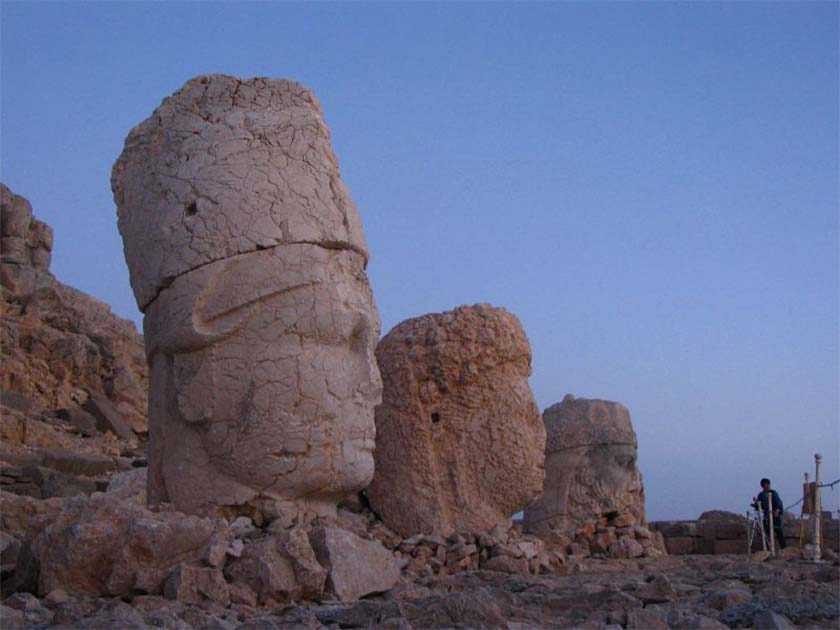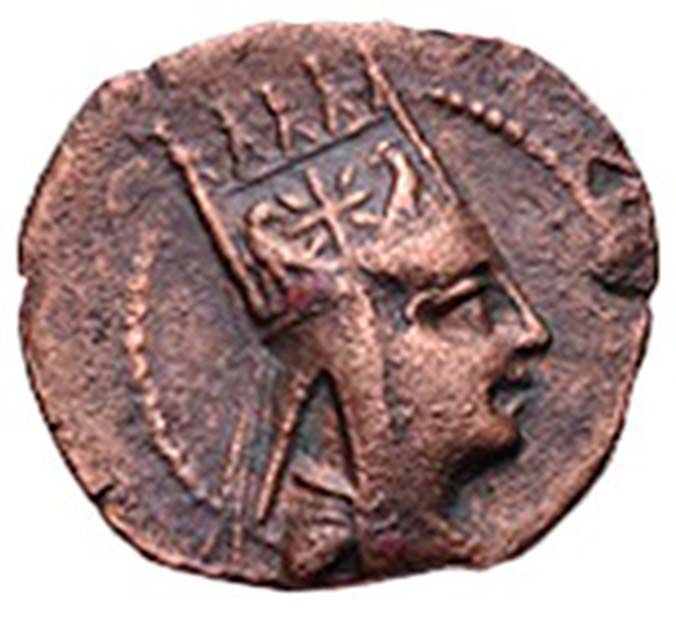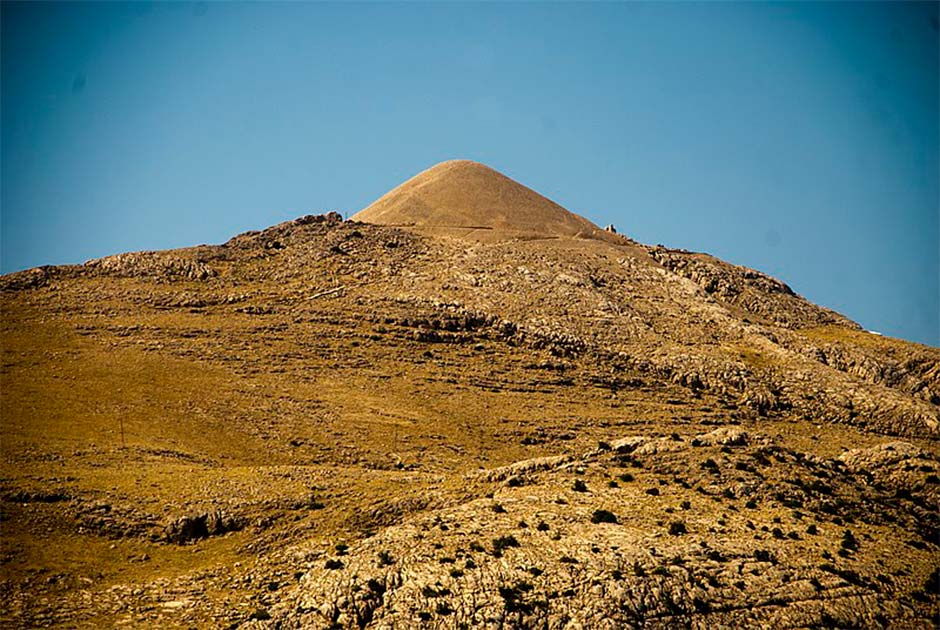Mount Nemrut, or Nemrud, is a mountain in southeastern Turkey measuring around 2,134 meters (7,000 feet) high. Atop its summit, lies several statues suspected to be the guardians of a royal tomb dating all of the way back to the 1st century BC.
It is one of the highest peaks in the Taurus Mountains, a remote and inaccessible place to construct such a tomb, let alone one so large. The tomb structures on top of the mountain encompass an area of 145m (475 feet) in diameter with a 50 meter (165 feet) funerary mound.
It is thought to have been built by the late Hellenistic King Antiochus I of Commagene, but it also seems to have been a monument to himself. To date, it is one of the most ambitious constructions visible from the Hellenistic period and remains almost unrivaled in the ancient world. However, many of its secrets still remain undiscovered.
More than a Tomb?
The mountain itself lies around 25 miles (40 km) north of Kahta, near Adiyaman. In 62 BC, King Antiochus I of Commagene ordered this tomb/sanctuary flanked by monumental statues measuring 8-9 meters (26 to 30 feet) high.
These statues depicted himself, two eagles, two lions, and a variety of Gods from both Greek and Iranian cultures. These included Heracles, Ares, Zeus, Oromasdes, Mithras, Helios, and Hermes.

Whilst he was constructing this magnificent pantheon, Antiochus was heavily influenced by the local Armenian and Parthian traditions by which he hoped to rejuvenate the religion of his ancestors. Originally these statues were enthroned and had their names inscribed upon them but at some point, in history, their heads were removed and scattered across the site.
- Casimir IV Jagiellon: A Polish King with a Cursed Tomb?
- The Secret Gods of the Greek Pantheon: Who Were the Cabeiri?
The nature of the damage to the statues indicates that there was likely a deliberate attack on them during a period of iconoclasm. The statues were never restored. Additionally, the site also preserves many stone reliefs of different figures, that scholars have concluded could be pieced together to create a large frieze.
It is suspected that these images relate to Antiochus’s heritage through both his Greek and Persian ancestors. The statues that exist on the site can also be found at the grave mound that exists in the area.
Likely this was placed here to protect the tomb from any robbers. Any attempt to begin excavating the site would lead to the mound caving in on itself. The statues found here follow a Grecian design for their face but a Persian one for the clothing and hairstyles.
Along the Western Terrace, there is a large slab that depicts a lion with an arrangement of stars and planets. These have been identified as Jupiter, Mercury, and Mars. It may be a star chart of the astronomy that could have been visible in July 62 BC which is the likely composition date of the monument.
The portion of the Eastern side is composed of several layers of rock and has a path that follows the base of the mountain. The path also indicates that there was a walled passageway linking the East and the West terrace. Possible uses for this site have been indicated as religious ceremonies due to the astronomical and religious nature of the statues and the monument.
King Antiochus I
Antiochus I was the son of Queen Laodice VII Thea of Commagene and Mithridates I Callinicus. He was half Iranian and through this was part of the Orontid Dynasty from Armenia and half Greek. Mithridates was the son of King Sames II Theosebes Dikaios of Commagene and was possibly related to the kings of Parthia.
The most prominent connection that Antiochus has is the dynastic link to Diadochi who were very close to Alexander the Great. Antiochus was raised to rule and took the throne of his father when he died in 70 BC. He later married Isias, the daughter of King Ariobarzanes I of Cappadocia, and had five children: Mithridates II of Commagene, Laodice, Prince Antiochus II, and Antiochis.
- Ain Dara’s Footprints: Did Gods Once Walk Among Us?
- The Hidden River of Mercury at Teotihuacan: Path to the Royal Tombs?
It is important to understand that Commagene was a minor kingdom located in Northern Syria’s highlands, along the border of Cappadocia. Initially, it served as a vassal state of the Seleucids, a center of Hellenistic culture, which massively influenced Commagene.
In the 1st century BC however, Iranian culture began to experience a resurgence and popularity. This was massively supported by Commagene to highlight its own claims of ancient ancestors and reinstate its rights over its own territory against the Seleucid, Parthian, and Roman powers.

Unfortunately, during Antiochus’ reign, Commagene faced hardships as the Roman War began to spill over into it. Antiochus chose to side with the Romans when Pompey declared war on him. Antiochus was treated distrustfully by the Romans and was sieged in 38 BC. His life becomes obscure after this but according to Cassius Dio, he was killed by the Parthian king Phraates IV.
The Dedication on Mount Nemrut
The impressive monument and sanctuary on Nemrut were begun by Antiochus in order to build a royal cult following for himself and for him to be worshipped after his death. It was inspired by the Greek form of the religion Zoroastrianism.
Antiochus left many inscriptions which revealed a lot of details about the religion and explained his own purpose. He hoped to be buried in a high place that would be closer to the gods whom he would hope to be numbered. Antiochus hoped to be preserved for eternity and to be placed amongst the Greek and Iranian Gods.

Antiochus practiced a very esoteric kind of astrology and laid a foundation for a calendrical reform. He linked the Commagernian year, which had been based on the moon’s movements, and the Star of Sirius. It indicated that Antiochus was knowledgeable to at least some extent about Egyptians and Hermeticism.
The tomb was constructed in a way that religious festivities could be held there. Every month he had two feast days. Despite this being a religious space, it was forgotten for centuries until German archaeologists found it in 1883. Through the inscriptions they found, it is clear that Antiochus was heavily pious and thought himself a generous spirit.
Top Image: The Stone Statues and the Façade of the Tomb of Nemrut. Source: Zhengan / CC BY-SA 4.0.
By Kurt Readman